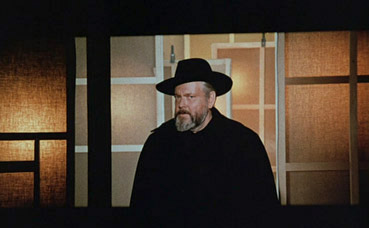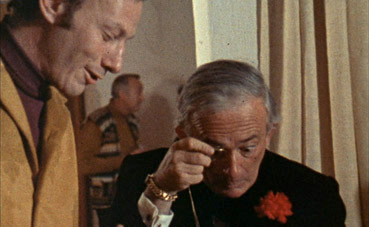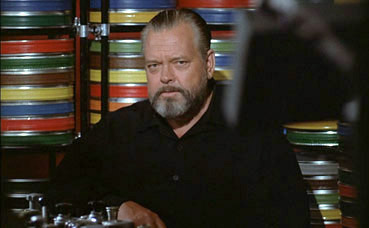|
Orson
Welles' 1974 F for Fake is a supreme example of a cinematic
sleight of hand, a magic trick deftly executed by a consummate
showman, one that misdirects the eye and on the first viewing
leaves you unsure whether you've been hit by an information
overload or been tricked into believing you have. Such uncertainty
is largely the result of Welles' own game-playing with the
film form, his non-linear storytelling and Three Card Monte
editing that delivers a fast-flowing stream of the factual
and the fanciful, on the way throwing up a wealth of debate
points about the art, authorship and the nature of truth.
F
for Fake is, true to its title, a film about lies
and fakery and two of its more notorious practitioners,
Elmyr de Hory and Clifford Irving. As with so much in the
film, the two are inextricably linked. Elmyr was one of
the art world's most successful forgers and Irving his biographer,
although Irving himself was later exposed as the forger
of an autobiography of Howard Hughes. But this is just the
kicking-off point for Welles and his "new kind of film."
He quickly establishes himself up as a central character
in his own story, a self-proclaimed charlatan and constantly
amused host who regales colleagues in restaurants and swaps
forged signatures with Emir on their respective artworks. Later,
he recalls his own claim to widespread notoriety as a master
deceiver with his 1938 radio broadcast that presented H.G. Wells' War of the Worlds as a factual
news report, one that sent half of its audience scurrying for the
hills. This mischievous fakery continued with
his celebrated first film, the lead character of which was
based so accurately on newspaper tycoon William Randolph
Hearst that newsreel shots of Hearst Castle in San Simeon
look today like Citizen Kane outtakes.
He teases us with suggestions that ludicrously wealthy Howard
Hughes was the originally intended target, but are we being
educated or hoodwinked here? Is this just a ruse to provide
Welles with a segue to a section on the life of a man he
was clearly fascinated by?

But
there's more. Much of F for Fake wasn't
shot by Welles at all but by filmmaker François Reichenbach
for a television documentary on Elmyr, something Welles
acknowledges from the start in a playful opening sequence
on a station platform, where he waves to Reichenbach and
his film crew, exchanges words with his beautiful girlfriend
Oja Kodar and performs conjuring tricks for entranced children,
before being transformed in two zooms and an edit to a studio
interior, neatly reminding us that film, even documentary
film, is essentially an illusion of reality. So much of F for Fake is multi-layered that you need
at least three viewings to begin unpicking the complexities
and separating the truth from the fiction. This almost
invisible marriage of opposites extends to the technique,
right down to the seemingly decorative, with the story of
Welles' War of the Worlds broadcast accompanied
by extracts from the 1956 Earth Vs. the Flying Saucers,
an alien invasion film whose special effects were created
by the great Ray Harryhausen, fake flying saucers in a fictional
story used to illustrate a true tale of another fiction
that was sold to the public as fact. And this is just one
small example from very many.
Welles
leads us on a breathless cinematic quickstep through lives
and work constructed around false images of truth, and in
the process admits an admiration for Elmyr and the
skill and the scale of his fakery. It's hard not to agree – after all, if quality and value are measured solely by
opinion, as they are in all of the arts, then where do you
look for absolute truth? More to the point, can it actually
exist in art at all in objective terms? It's no use scanning
the following paragraph for an answer as I don't have one,
and anyone who claims to do so is living inside an ego bubble
that I urge you to burst with whatever tool comes to hand.
Just take a trip around the IMDb and look at the user comments
on almost any film you care to name and you'll encounter
a wide diversity of opinion. So which one is right? Which
represents the real 'truth'? Why, the one that most closely mirrors your view, of course. Opinion is the currency of art appreciation
and criticism, and an artwork only acquires financial value
when the opinion of self-styled
'experts' and those with the money to outbid each other
for it achieves widespread concensus. That Welles' own work had at this point in his career
been repeatedly undervalued by those who trade in opinion
was doubtless a contributory factor to the wry amusement
he displays here, and your take on his intentions could
well be shaped in part by your own attitude to art and its
value.

So is Welles being playfully serious or seriously playful? Is he sharing
a joke or playing one on us, or both? Does it actually matter?
Hell no. Welles once stated that filmmaking was "The
biggest electric train set a boy ever had," as neat
an encapsulation of the fun that participating in the process
can be when you're working with the right people on the
right project. More than almost any other film he made, F for Fake seems to epitomise that sentiment – this is Welles having the best of fun with his train set,
right down to the tale's amusing final twist. Part documentary,
part essay film, part self portrait and part cinematic prank
of the highest order, F for Fake is a kaleidoscopic,
dazzlingly edited one-of-a-kind that drives a bullet train
through documentary film conventions, and is one of those
rare films that is as enjoyable, memorable and (crucially)
meaningful for its technique as for its content.
Framed
1.66:1 and anamorphically enhanced, this appears to be another
of Masters of Cinema's licences of Criterion transfers,
although this one is a PAL disc sourced from Criterion's
high definition master. F for Fake presents
a challenge to any attempt at a pristine transfer due to
its mix of (then) newly shot 35mm sequences and material
from a range of other sources, including Reichenbach's
16mm footage. Some of this appears to have been cropped
a little at the top and bottom to fit the 1.66:1 framing,
but that would have been by Welles himself – the framing
on the 35mm work done by regular Welles collaborator Gary
Graver looks fine. The quality of the image also varies
according to the stock used, with the 35mm having superior
sharpness, colour and contrast to the older 16mm and at
times is very impressive. Film grain is very evident on
all of the 16mm shots and there is more dust and dirt here,
although this was very likely carried over in the original
transfer to 35mm. On the whole, this is probably as good
a job as you could hope for, given the original material.

The
mono 2.0 soundtrack is clear and free of fluff and major
distortion, although the dynamic range is inevitably limited
and the music doesn't have the punch of a more modern film.
In a couple of shots there appear to be minor sync issues,
suggesting perhaps a little post-dubbing work on Orson's
part, perhaps. Otherwise, no problems.
Commentary
by Gary Graver and Bill Krohn
The film's cinematographer and the US correspondent of Cahiers
du cinéma take us through the film, with Krohn
enthusing over Welles' editing and, together with an unnamed
other, prompting Graver for his memories of the shoot and
working with Orson. Graver usefully settles some points
of speculation, some to Krohn's considerable surprise, as
well as providing choice background on some of the technical
aspects of the shoot and his own history as a cameraman.
It's all interesting and sometimes revealing stuff with
a poignant end – Graver asks to stop because he is getting
tired, and a few months later died of complications from
cancer. The DVD is dedicated to his memory.
Jonathan
Rosenbaum on F for Fake (27:41)
A visually straightforward but interesting and enthusiastic
address to camera by author and critic for the Chicago
Reader Jonathan Rosenbaum. There are a couple of brief
crossovers with the commentary, but otherwise this is a
good companion piece that never gets overly analytical.
He talks a lot about Welles and his career, and shares with
Krohn a particular enthusiasm for Welles' 9 minute trailer
for the film. I was originally disappointed that this trailer
was not included as an extra feature, but the day after
my original review was posted I received an email suggesting
that I look a little harder (see below).
Booklet
Another very fine booklet that's well up to the usual Masters
of Cinema standard. Included is a substantial essay on the
film by Welles author Joseph McBride, a piece on Chartres
Cathedral by Fred Camper (see the film to get the relevance),
an interview with one of the film's editors, Bill Haugse
(later nominated for an Academy Award for his work on Hoop
Dreams), and an essay loaded with questions by
Craig Keller.
Easter
Egg: The Trailer
(8:45)
And there I was complaining about its non-inclusion and
all the while I had simply failed to fully enter into the spirit
of things and go looking for it. Welles' much admired but
never screened in theatres trailer is an extraordinary work
in its own right. Presented by DoP Gary Graver and deliriously
edited, this clearly gave Welles almost as much fun as the
main feature and no doubt had distributors holding their
heads in their hands.
To
access the trailer, select the Commentary from the main
menu. On the Commentary page click the 'up' button on your
remote twice and a large question mark will appear in the
bottom right of the screen. Press 'select' and the trailer
will run.
One
of Welles' most enjoyable and playful films, F for
Fake is also one of his most densely packed and
multi-layered, something you only really appreciate with
multiple viewings. Masters of Cinema's DVD benefits from
a very decent transfer, a consistently informative commentary,
the enthusiastic Jonathan Rosenbaum and typical fine booklet,
but still loses out to the Criterion 2-disc set, which also
has a commentary (with Gary Gravers and Oja Kodar), an 88
minute documentary on Welles' unfinished projects, a 52
minute documentary on Elmyr de Hory, a 60 Minutes
interview with Clifford Irving about his Howard Hughes autobiography
hoax, a 1972 press conference at which the hoax was exposed
and, yes, that much talked about 9 minute trailer. But if
you're not worried about those extra supplements and don't
want to cough up for the Criterion price, then the Masters
of Cinema disc still delivers and comes recommended.
|